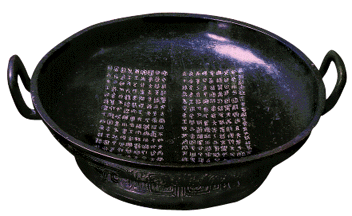Sang Shi Pan
Chinese Bronze Vessel
This sang shi pan, also called ze ren pan,
is one of several kinds of Chinese ancient bronze vessels used for holding
water. Most vessels that have two handles on either side were made
during the Western Chou and Spring Autumn period. Small
pan were used for washing the face and hands. Larger ones are used
for bathing.
The vessel shown above was made in the late Western
Chou dynasty. The engraving on the inside surface is composed of
375 characters. It records how the feudal ruler "Ze" gave a piece
of land to the nobleman "Sang." Also, it clearly described
the size of the land by referring to some trees, rivers, roads and mountains
as land marks. In addition, a witness (or witnesses) are listed who
all gave oaths to abide by the contract. This writing is often referred
to as the Western Chou surveyor‚s registry by historians. |
|
|
|
 |
Time and Location: Monday
through Friday, Winter 2000
12:30-1:18,
IH 100,
(Independence Hall) 
Professor: Dr. Mark
Bender
101 Cunz Hall, Tel: 292-1746, E-mail:
Office hours: M,W 2 - 3 pm
Teaching Assistants: TBA
TA offices: 467 and 468 Cunz Hall 
Tel: 292-9537 (Japanese and Korean TAs); 292-0676 (Chinese TAs)
The Department of East Asian Languages and
Literatures (DEALL)
Office: 204 Cunz Hall,
Tel: 292-5816
Note: E-mail is checked twice a week.
Please do not e-mail for test results. Urgent messages may be left
on the instructor's answering machine. Read our web-page for occasional
extra-credit notices in the "Weekly Special."  |
 |
Course Description:
This course is an introduction to elements of the contemporary and
traditional cultures of China, Korea, and Japan. It provides students
with a fundamental, yet diverse knowledge of the dynamic, emerging cultural
and economic powerhouses in East Asia. Multi-media methods, lectures,
readings, and discussions are utilized in the instruction. |
 |
Themes and Objectives:
The aim of this course is to introduce students to the rich cultural
heritage and current lifestyles of East Asia, defined in this course as
the countries of China, Korea, and Japan. The growing prominence
of the region is felt worldwide in terms of economic and political influence
and power, technological and artistic innovation, population and ecological
issues, and the emerging world consumer culture. Through this course,
students will learn to perceive points of similarity and difference between
the three major cultural traditions of East Asia and gain a basis for understanding
the unique natures and inter-relationships of these cultures in historic
and contemporary contexts, both regionally and internationally. |
 |
Topics:
History, traditional belief systems, society and personality, languages,
arts and literatures, performance traditions, folklore, daily life and
customs, ethnicity and gender issues, science and technology, business,
government, current social issues, and the international implications of
a powerful and dynamic East Asia linked into the emerging world economy
and consumer culture of the coming 21st century. |
|






